The Lowly, but Ubiquitous, Worm
April 18, 2016
One advantage of raising
children is that you get to relive some of the fun of your own
childhood. I've always enjoyed reading children's
picture books, my favorites being the books by
Richard Scarry. One memorable
character from his many books is
Lowly Worm, an
anthropomorphic earthworm wearing a
Tyrolean hat and a single
shoe. You can see him in action in various
YouTube animations.[1]
Worms are a part of
popular culture in such phrases as "book worm," another name for a
bibliophile. Not surprisingly, I was a book worm in my youth, although now I do nearly all my reading from a
computer screen. I can't be called a
computer worm, since that term is already used to describe a form of
malware. The first, and most famous, computer worm, is the
Morris worm that infected the early
Internet in 1988.
There's a
joke that a collection of
aphorisms spoken by
Ludwig Wittgenstein as he paused to tie his shoes would be a best selling book. Wittgenstein had something to say about worms, "May God enlighten me. I am a worm, but through God I become a man."[2]
US President,
Franklin Delano Roosevelt, also has a
memorable worm quotation, " I sometimes think we consider too much the good
luck of the early
bird and not enough the bad luck of the early worm."
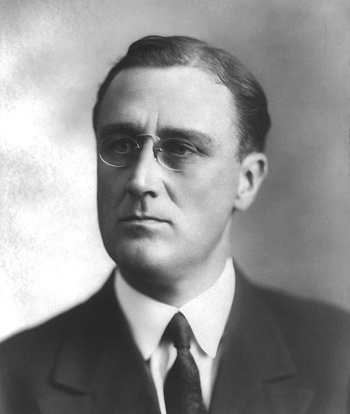
A circa 1919 portrait of US President, Franklin Delano Roosevelt (FDR), when he served as Secretary of the Navy.
FDR was the only American president to serve more than two terms. He died shortly into his fourth term. The Twenty-Second Amendment, ratified in 1951, limited the presidency to two terms
(Photograph from the United States Library of Congress Prints and Photographs Division, via Wikimedia Commons.)
As we've learned in
elementary school science, the lowly
earthworm (an
Annelid of the class
oligochaeta) is of great benefit to
mankind. It's even been suggested that earthworms would make a good
protein supplement for
humans. Fortunately, the
Wikipedia page about the
Diet of Worms is on a different topic altogether.
Earthworms play a major role in
soil improvement by conversion of
organic matter, such as
leaves, into
humus. Earthworm
excrement contains a rich mixture of
nitrates,
phosphates, and
potassium that
fertilize plant growth. Earthworm
burrows aid in the
aeration and
drainage of soil.
The earthworm was the topic of
Charles Darwin's last book, "
The formation of vegetable mould through the action of worms with observations on their habits," which was published in 1881, just six months before he died. This book addressed not only the
ecology of worms, but the question of how
intelligent they might be. Darwin performed some simple
experiments to elucidate worm intelligence.
This book contained, also, an estimate of the
areal density of worms in soil. Darwin's number, 53,000 worms per
acre (13/
square meter), is somewhat lower than current estimates that range from 250,000-1.7 million depending on
soil quality.
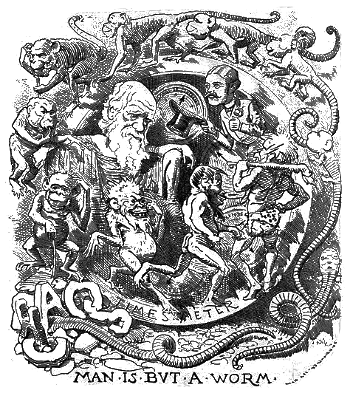
Evolution of man from the worm, with a caricature of Charles Darwin.
(A Wellcome Trust image, photo number, L0003921, via Wikimedia Commons.)
Earthworms are everywhere, but
data on their precise
geographical distribution have been lacking. To remedy this uncertainty,
researchers from eight
European countries collected information on earthworm communities, and they mapped their
biodiversity.[3-4] The members of the research team were from the
National Institute for Public Health and the Environment (Bilthoven, The Netherlands), the
Joint Research Centre (Ispra, Italy), the
University of Parma (Parma,Italy),
ECT Oekotoxikologie GmbH (Flörsheim am Main, Germany), the
Centre for Ecology and Hydrology (Lancaster, UK), the
James Hutton Institute (Dundee, UK),
University College Dublin (Belfield, Ireland), the
Agri-Food and Biosciences Institute (Belfast, UK),
Blackshaw Research & Consultancy (Devon, UK),
Agrocampus Ouest-INRA SAS (Rennes, France), the
University of Rennes, (Rennes, France), the
University of Vigo (Vigo, Spain), the
Universidad Complutense de Madrid (Madrid, Spain), the
University of Coimbra (Coimbra, Portugal), the
University of Ljubljana (Ljubljana, Slovenia),
Aarhus University (Silkeborg, Denmark), and
Alterra, Wageningen UR (The Netherlands).[3]
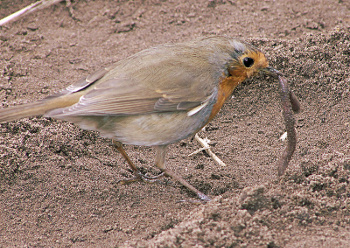
The early bird and his worm.
In this case, the bird is a European robin (Erithacus rubecula), and the worm is the common earthworm (Lumbricus terrestris).
(Photo by Rasbak, via Wikimedia Commons.)
Although few likely noticed, 2015 was the "
International Year of Soils."[4] It's amazing how much biodiversity exists in the topmost layer of
Earth's surface. Every
gram of soil contains millions of
organisms, and soils contain more than a quarter of Earth's
species, but there have been few published studies on soil
ecosystems.[4] Says
María Jesús Iglesias Briones, a
co-author of the study at the University of Vigo,
"The classification of edaphic invertebrates and their distribution patterns have not received priority for funding, meaning that a lot of information from unpublished studies has not been digitised."[4]
In their studies, the research team assembled existing earthworm data from 3838 sites in eight European countries.[3] Of these locations, 1,423 were from
France alone, a consequence of substantial French funding in this area.[4] Using the
computer technique of
multiple regression, they were able to relate earthworm density to such factors as
soil characteristics,
land use,
vegetation and
climate.[3] In the end, they were able to produce some impressive graphics, two examples of which are shown below.[3]
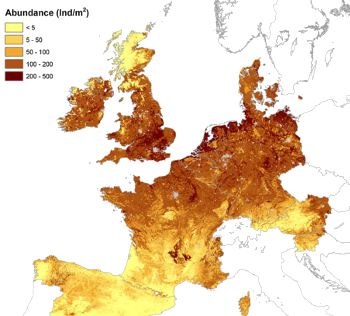
Earthworm abundance.
(From Rutgers, et al.[3])
(Click for larger image)
![]()
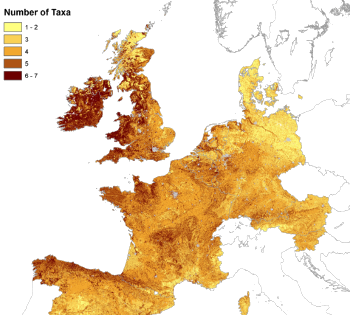
Earthworm diversity.
(From Rutgers, et al.[3])
(Click for larger image)
The analysis determined that climate is more important than geography to earthworm distribution, while land use was an important factor in determining their
demography and
diversity.[3] Says Briones, "We hope that studies such as this one put a greater weight on the need to understand the diversity of these invertebrates that are so important to the proper functioning of soils."[4]
References:
- The Busy World of Richard Scarry - Lowly Breaks His Leg, YouTube Video, Uploaded February 25, 2010.
- Kai-man Kwan, "Rainbow of Experiences, Critical Trust, and God: A Defense of Holistic Empiricism," Continuum International Publishing Group (New York, August, 2011), p. 29 (via Google Books).
- Michiel Rutgers, Alberto Orgiazzi, Ciro Gardi, Jörg Römbke, Stephan Jänsch, Aidan M. Keith, Roy Neilson, Brian Boag, Olaf Schmidt, Archie K. Murchie, Rod P. Blackshaw, Guénola Pérès, Daniel Cluzeau, Muriel Guernion, Maria J.I. Briones, Javier Rodeiro, Raúl Piñeiro, Darío J.Díaz Cosín, J.Paulo Sousa, Marjetka Suhadolc, Ivan Kos, Paul-Henning Krogh, Jack H. Faber, Christian Mulder, Jaap J. Bogte, Harm J.van Wijnen, Anton J. Schouten, and Dick de Zwart, "Mapping earthworm communities in Europe," Applied Soil Ecology, vol. 97 (January 2016), pp. 98-111.
- The first European earthworm map is drawn, Spanish Foundation for Science and Technology Press Release, February 24, 2016. Press release in Spanish.
Permanent Link to this article
Linked Keywords: Child; children; childhood; picture book; Richard Scarry; character; Lowly Worm; anthropomorphic; earthworm; Tyrolean hat; shoe; YouTube; animation; popular culture; bibliophilia; bibliophile; computer monitor; computer screen; computer worm; malware; Morris worm; Internet; joke; aphorism; Ludwig Wittgenstein; President of the United States; US President; Franklin Delano Roosevelt; memorable worm quotation; luck; bird; portrait; United States Secretary of the Navy; Twenty-second Amendment to the United States Constitution; ratification; ratify; term limits in the United States; United States Library of Congress; Prints and Photographs Division; Wikimedia Commons; elementary school; science; earthworm; Annelid; oligochaeta; human; mankind; protein; dietary supplement; Wikipedia; Diet of Worms; soil; organic matter; leaf; leaves; humus; feces; excrement; nitrate; phosphate; potassium; fertilize; plant morphology; plant growth; burrow; aeration; drainage; Charles Darwin; The formation of vegetable mould through the action of worms with observations on their habits; ecology; intelligence; intelligent; experiment; areal density; acre; square meter; soil quality; human evolution; evolution of man; caricature; Wellcome Trust; data; geography; geographical; research; researcher; Europe; European; country; biodiversity; National Institute for Public Health and the Environment (Bilthoven, The Netherlands); Joint Research Centre (Ispra, Italy); University of Parma (Parma,Italy); ECT Oekotoxikologie GmbH (Flörsheim am Main, Germany); Centre for Ecology and Hydrology (Lancaster, UK); James Hutton Institute (Dundee, UK); University College Dublin (Belfield, Ireland); Agri-Food and Biosciences Institute (Belfast, UK); Blackshaw Research & Consultancy (Devon, UK); Agrocampus Ouest-INRA SAS (Rennes, France); University of Rennes, (Rennes, France); University of Vigo (Vigo, Spain); Universidad Complutense de Madrid (Madrid, Spain); University of Coimbra (Coimbra, Portugal); University of Ljubljana (Ljubljana, Slovenia); Aarhus University (Silkeborg, Denmark); Alterra, Wageningen UR (The Netherlands); european robin; Erithacus rubecula; Lumbricus terrestris; International Year of Soils; lithosphere; Earth's surface; gram; organism; species; ecosystems; María Jesús Iglesias Briones; co-author; edaphic; invertebrate; funding of science; digitizing; digitised; France; computer model; computer technique; regression analysis; multiple regression; soil characteristics; land use; vegetation; climate; demography; biodiversity; diversity.